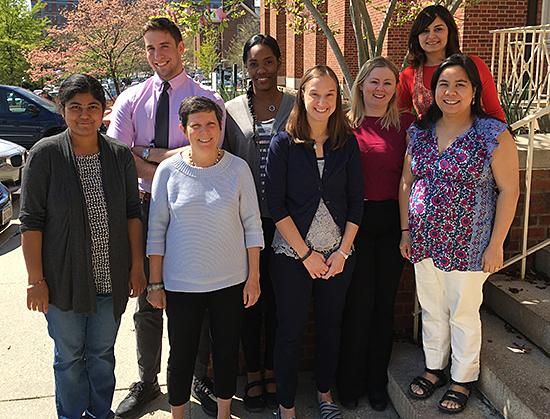Human Eosinophil Section
Amy Klion, M.D.
Co-Deputy Chief, Laboratory of Parasitic Diseases
Chief, Human Eosinophil Section

Major Areas of Research
- Identification and characterization of new subtypes of hypereosinophilic syndromes (HES)
- Elucidation of the role of the eosinophil in pathogenesis of eosinophilic disorders
- Assessment of the safety and efficacy of chemotherapeutic agents targeting eosinophils (or their precursors)
- Prevention of post-treatment reactions in loiasis, a filarial infection associated with dramatic eosinophilia following anthelminthic therapy
Program Description
The Human Eosinophil Section conducts basic and translational research related to the role of the eosinophil and eosinophil activation in disease pathogenesis, with the ultimate goal of developing novel diagnostic tools and treatment approaches for hypereosinophilic syndromes and other conditions associated with marked eosinophilia, including helminth infection.
Using a translational approach, distinct clinical subgroups of patients with HES have been identified and characterized, including a myeloproliferative form of HES that includes FIP1L1/PDGFRA-positive chronic eosinophilic leukemia and an autosomal dominant form of familial eosinophilia that has been mapped to chromosome 5q31-33. Laboratory studies have focused on the role of eosinophils and eosinophil activation in producing the very different clinical presentations and outcomes of these disorders. Clinical trials using targeted therapies, including imatinib mesylate and monoclonal antibodies to IL-5 and IL-5 receptor, have provided additional insight into the etiology and pathogenesis of HES variants.
Eosinophilia is common in human helminth infection and may be associated with pathologic sequelae that mimic the clinical findings in HES, including tissue fibrosis and "allergic" manifestations. Furthermore, these manifestations may be produced or exacerbated by anthelminthic therapy. Prior research in the Helminth Immunology Section has demonstrated that these exacerbations are accompanied by an increase in IL-5, eosinophils, and markers of eosinophil activation. Consequently, a second major focus of our section is to explore further the role of the eosinophil in post-treatment reactions and to use novel approaches to limit the pathology seen in these settings.
Clinicians in the Human Eosinophil Section, along with others in the Laboratory of Parasitic Diseases, form the Clinical Parasitology Section, which has played a major role in the training of physicians for careers in tropical medicine.
Biography
Education
B.A., Princeton University
M.D., New York University School of Medicine
Dr. Klion earned her B.A. from Princeton University and her M.D. from New York University School of Medicine. After completing a residency in internal medicine at Johns Hopkins University, she was a postdoctoral fellow in the Laboratory of Parasitic Diseases from 1989 to 1991. She completed her fellowship in infectious diseases at the University of Iowa Hospitals and Clinics in Iowa City, Iowa, where she was appointed an assistant professor in the division of infectious diseases prior to returning to the Laboratory of Parasitic Diseases in 1997 as a staff clinician. She became a tenure-track clinical investigator in the Laboratory of Parasitic Diseases in 2009 and a senior clinical investigator in 2014.
Clinical Studies
Selected Publications
Khoury P, Desmond R, Pabon A, Holland-Thomas N, Ware JM, Arthur DC, Kurlander R, Fay MP, Maric I, Klion AD. Clinical features predict responsiveness to imatinib in platelet derived growth factor receptor alpha-negative hypereosinophilic syndrome.Allergy. 2016 Jan 21. Epub ahead of print.
Klion AD. How I treat hypereosinophilic syndromes. Blood. 2015 Aug 27;126(9):1069-77.
Khoury P, Herold J, Alpaugh A, Dinerman E, Holland-Thomas N, Stoddard J, Gurprasad S, Maric I, Simakova O, Schwartz LB, Fong J, Lee CC, Xi L, Wang Z, Raffeld M, Klion AD. Episodic angioedema with eosinophilia (Gleich syndrome) is a multilineage cell cycling disorder. Haematologica. 2015 Mar;100(3):300-7.
Legrand F, Tomasevic N, Simakova O, Lee CC, Wang Z, Raffeld M, Makiya MA, Palath V, Leung J, Baer M, Yarranton G, Maric I, Bebbington C, Klion AD. The eosinophil surface receptor epidermal growth factor-like module containing mucin-like hormone receptor 1 (EMR1): a novel therapeutic target for eosinophilic disorders. J Allergy Clin Immunol. 2014 May;133(5):1439-47, 1447.e1-8.
Chen YY, Khoury P, Ware JM, Holland-Thomas NC, Stoddard JL, Gurprasad S, Waldner AJ, Klion AD. Marked and persistent eosinophilia in the absence of clinical manifestations. J Allergy Clin Immunol. 2014 Apr;133(4):1195-202.
Klion AD, Mejia R, Cowen EW, Dowdell KC, Dunleavy K, Fahle GA, Holland-Thomas N, Maric I, Pittaluga S, Raffeld M, Santos C, Stetler-Stevenson M, Krogmann T, Shatzer AN, Turk SP, Yin Y, Xi L, Prussin C, Cohen JI. Chronic active Epstein-Barr virus infection: a novel cause of lymphocytic variant hypereosinophilic syndrome. Blood. 2013 Mar 21;121(12):2364-6.
Research Group

Human Eosinophil Section Research Group
From left to right: Senbagavalli Prakash Babu, Nicholas Kovacs, Amy Klion, Kindra Stokes, Michelle Makiya, Fanny Legrand, Paneez Khoury, Fei Li Kuang

